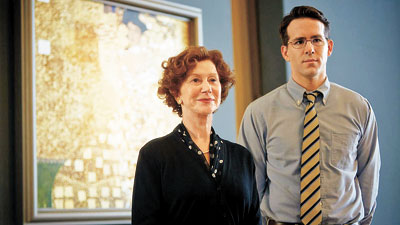
This film is based on a true story.
Austrian-Jewish Holocaust refugee* Maria Altmann (Helen Mirren) had lived in California since fleeing* Europe with her husband during World War II when the death of her sister brought documents* to light about a number of Klimt paintings and other valuables robbed by the Nazis from the home of her Viennese family.
One of the Klimts had special meaning to her. Richly decorated with gold leaf, it depicted* her beloved aunt, Adele Bloch-Bauer, who had lived with the Altmanns until her death from meningitis* at age 43, and was like a second mother to Altmann and her sister.
Hanging in the Belvedere Palace since the war, the painting had come to be thought as Austria’s “Mona Lisa,” while the museum had buried the paperwork about its origin.
Altmann asks for help from struggling young lawyer Randy Schoenberg (Ryan Reynolds) to look over papers and see if she has a case to get back her family possessions*, including the Klimt portrait.
The son of a judge and grandson of the famed composer, Schoenberg represents a generation descended from Holocaust survivors who have often struggled to share the burdens of memory.
The film is most interesting when Altmann rethinks her refusal* to return to Austria and goes with Schoenberg on their first trip to file a request with the national restitution* committee.
That visit brings back a flood of memories, in which she’s played as a young woman by “Orphan Black” star Tatiana Maslany.
Helped by a local journalist (Daniel Bruhl), the present-day Altmann and Schoenberg meet difficulties at every step.
Through it all, the dignified* Mirren rises above the occasion, even when the movie over dramatizes* her character’s pain and final bittersweet win. It’s a moving story of social injustice put right, and it would have been a better movie with a less heavy-handed retelling.(SD-Agencies)
|

